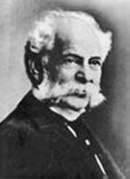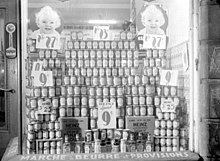Heinz
[3] Heinz ranked first in ketchup in the US with a market share in excess of 50%;[4][5] the Ore-Ida label held 46% of the frozen potato sector in 2003.[7] In February 2013, Heinz agreed to be purchased by Berkshire Hathaway and the Brazilian investment firm 3G Capital for $23 billion.Inspired by an advertisement he saw while riding an elevated train in New York City (a shoe store boasting "21 styles"), Heinz picked the number more or less at random because he liked the sound of it, selecting "7" specifically because, as he put it, of the "psychological influence of that figure and of its enduring significance to people of all ages".[13] He personally worked to control the "purity of his products by managing his employees", offering hot showers and weekly manicures for the women handling food.The auditorium included a pipe organ, and Heinz employed an organist to give recitals and musical programs.[20] During World War II, "Jack" Heinz led the company as president and CEO to aid the United Kingdom and offset food shortages.[1] By 2000, the consolidation of grocery store chains, the spread of retailers such as Walmart, and growth of private-label brands caused competition for shelf space, and put price pressure on the company's products.[1] The decline was also attributed to an inadequate response to broad demographic changes in the United States, particularly the growth in population among Hispanic and increased spending power of African Americans.[28] In 2001, Heinz acquired the pasta sauce, dry bouillon and soup business of Borden Foods.Some expressed surprise that it had responded to what they said was a relatively small number of complaints, compared to the UK's estimated 3.6 million gay and lesbian consumers.[36] MP Diane Abbott called the decision to withdraw the advert "ill-considered" and "likely to offend the gay community".Berkshire and 3G immediately named Bernardo Hees, former chief executive of Burger King Worldwide Inc, as the CEO.The Heinz Portion Control subsidiary is located in Jacksonville, Florida, and produces single-serving containers of ketchup, mustard, salad dressings, jams, jellies and syrups.[50] Heinz also had factories in the following locations:[51] Arizona (Phoenix); California (Chatsworth, Escalon, Irvine, San Diego); Florida (Fort Myers); Idaho (Pocatello); Iowa (Cedar Rapids, Muscatine); Massachusetts (Newburyport); Ohio (Mason, Massillon); Oregon (Ontario), and South Carolina (Florence).[53] Heinz manufactures "Big Red" tomato sauce, and a number of flavored baked bean varieties, as well as canned meals.[57] A local group was seeking to purchase the factory and start its own production, with offers of financial assistance from investors.[57] As of May 2020 Kraft Heinz is said to potentially be in discussions with Graeme Hart to sell off the brands of Wattie's in New Zealand and Golden Circle in Australia.A local effort began in an attempt to save the 105-year-old Leamington plant, and it included creating a Facebook page to gather support.[63] In April it was reported that Highbury Canco Corporation had received a one-year license to process tomatoes at the facility, saving some 250 jobs.[75] Subsequently, Heinz suffered severe supply issues for the ex-HP Foods brands as the Elst factory struggled to integrate production, resulting in significant negative coverage from UK retailers.[77] Netherlands factories are also responsible for producing signature sauces such as mayonnaise and ketchup for its Southeast Asian market.The site specialized in baby milks, previously under the brand of Farley's, but then manufactured under the name Heinz Nurture.[citation needed] Heinz produces oriental foods sold under the Amoy brand, once used under license from Ajinomoto Co. Inc., Tokyo, Japan.









Heinz (disambiguation)DivisionTraded asFood processingSharpsburgPennsylvaniaHenry J. HeinzKraft HeinzPittsburghParentPPG PlacePittsburgh, PennsylvaniaketchupOre-Ida57 VarietiesBerkshire Hathaway3G CapitalKallstadtBavarianRhenish PalatinateRhineland-PalatinateHaunetalHesse-KasselVerdun, QuebecSharpsburg, PennsylvaniahorseradishHeinz Tomato KetchupPure Food and Drug ActLeamington, OntarioWorld War ISalad Cream1936 Pittsburgh floods"Jack" HeinzStarkist TunaTony O'Reillymanaging directorStandard & Poor'sWalmartprivate-labeldemographic changes in the United Statesgrowth in population among HispanicCalPERSWilliam R. JohnsonBorden FoodsTGI FridaysNelson Peltzproxy battle9LivesDel Monte FoodsAdvertising Standards AuthorityhomophobiaStonewallDiane AbbottBernardo HeesBurger King Worldwide IncMcDonald'sBurger KingBull's-EyeComplanDaddiesGreenseasHP SauceJack Daniel'sLea & PerrinsBagel BitesT.G.I. Friday'sWattie'sWeight WatchersWyler'sHeinz Baked BeanskeystoneHeinz FieldFremont, OhioMuscatine, IowaHolland, MichiganJacksonvilleArizonaPhoenixCaliforniaChatsworthEscalonIrvineSan DiegoFloridaFort MyersPocatelloCedar RapidsMuscatineMassachusettsNewburyportMassillonOregonOntarioSouth CarolinaFlorenceAlbertsonsSafewayWagga WaggaNew South WalesMelbournecanned baked beansNew ZealandGolden CircleGirgarre, VictoriaNorthgateEchucaMill ParkNorth York, OntarioSt. Marys, OntarioMontrealCalgaryFacebookFrench'sZydus WellnessIndonesiaPT. Heinz ABC IndonesiaJakartaSambalGelderlandBirmingham, West MidlandsHP FoodsCape Cornwall MineCape CornwallH. J. Heinz CompanyThe BrisonsPeckham